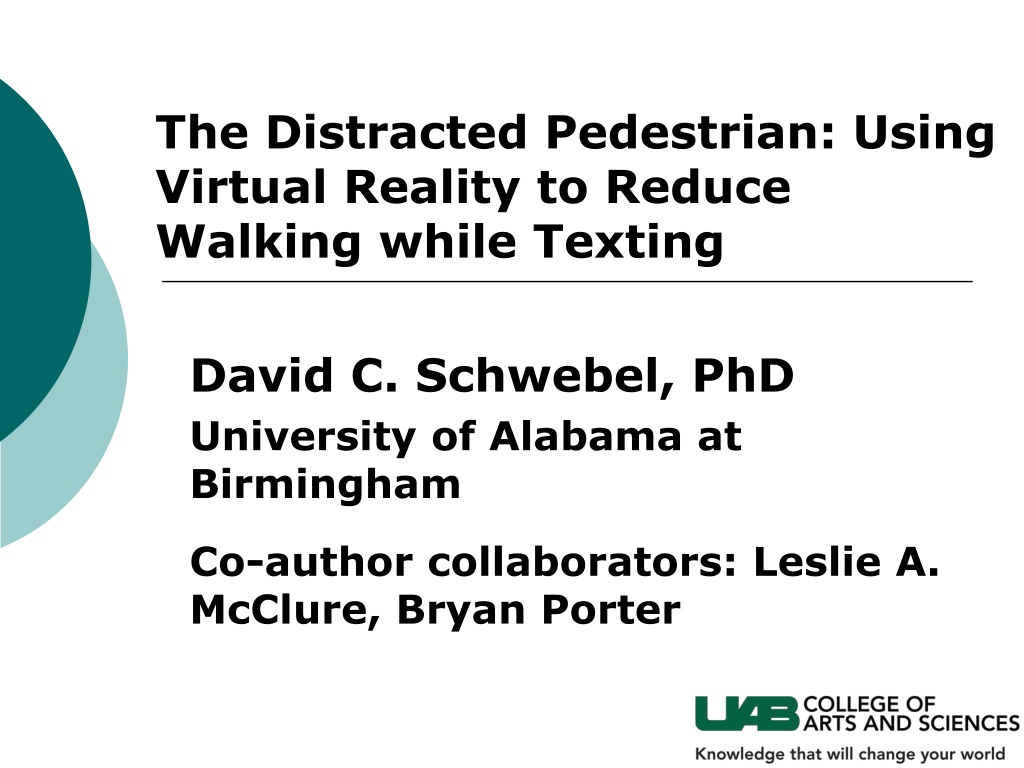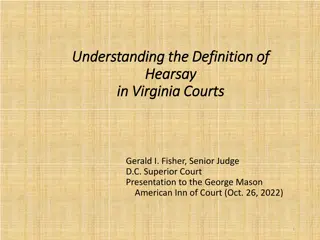Using Virtual Reality to Reduce Distracted Pedestrian Behavior on College Campuses
This study focuses on addressing the issue of distracted pedestrians, particularly on urban college campuses. By utilizing virtual reality technology, the aim is to reduce incidents of distracted walking, which is prevalent among young adults who heavily rely on smartphones. The research provides valuable insights into the scope of the problem, data collection methods, and outcomes observed at specific target intersections. Ultimately, the goal is to promote pedestrian safety and mitigate the risks associated with distractions such as texting while walking.
Download Presentation

Please find below an Image/Link to download the presentation.
The content on the website is provided AS IS for your information and personal use only. It may not be sold, licensed, or shared on other websites without obtaining consent from the author. Download presentation by click this link. If you encounter any issues during the download, it is possible that the publisher has removed the file from their server.
E N D
Presentation Transcript
The Distracted Pedestrian: Using Virtual Reality to Reduce Walking while Texting David C. Schwebel, PhD University of Alabama at Birmingham Co-author collaborators: Leslie A. McClure, Bryan Porter
Why the increase??? More driving lower cost gas More walking health promotion More distraction both drivers and pedestrians
Background of Our Study Goal: reduce distracted pedestrian behavior on urban college campuses Young adults have high rate of smartphone and technology use Urban college campuses have high rates of pedestrian activity
Scope of the problem Before describing details of intervention, how bad is the distracted pedestrian problem? Our baseline data explains. Two campuses Old Dominion University, Norfolk, VA University of Alabama at Birmingham, Birmingham, AL Two target intersections major boulevard with median and minor cross- street, signaled with traffic light Hampton Blvd & 45thSt in Norfolk University Blvd & 14thSt in Birmingham
Observational Data Collection - Methods Behavior coded continuously, weekdays 7:45 AM-5:45 PM 30 minute coding blocks from rotating single corner 3 sets of observations 5 minutes, traffic count 5 minutes, random selection of approaching pedestrian with observation for full crossing and detailed coding on individual differences, crossing behavior, and distraction 15 minutes, coding of all approaching pedestrians as distracted or not distracted (5 minutes rest/rotate)
Observational Data Collection - Outcomes Traffic count (vehicles/hour) 5-minute individualized coding Apparent gender Estimated age Enter with walk sign Look left before entering road Enter within crosswalk Look right while leaving median Exit within crosswalk Distraction and type (phone, text, headphones, etc.) Multiple distractions
Observational Data Collection - Outcomes 15-minute coding of all pedestrians Distracted vs. not distracted If distracted, Talking on phone Texting/looking down at phone Wearing headphones Reading Eating Other distractions Multiple distractions
Results: Baseline Scope of Problem 1,020 individualized observations 89% young adults 51% female No major demographic differences across campuses
Baseline Results: Individualized Pedestrian Distraction (N=1,020) 50% 45% 40% 35% 30% 25% 20% 15% UAB 10% 5% ODU 0% Overall
Baseline Results: Individualized Pedestrian Safety (N=1,020)
Results: Individualized Pedestrian Gender Differences (N=1,020) Distraction Women more likely to be distracted from talking on the phone, texting, and multiple distractions Men more likely to be distracted from headphones Safety Women more likely to exit within the crosswalk Men more likely to look right at median
Baseline Results: Distracted Pedestrians Engaging in Safe Behaviors (N=1,020)
Baseline Results: 33% of All Pedestrians were Distracted (N=9,523)
Scope of the problem Data show there is a problem - pedestrians are distracted on urban college campuses How do we create change??? Health behavior theory change is difficult
Health Behavior Change Distracted driving interventions show mixed results distracted pedestrian interventions are few in number Distracted driving policy change has some efficacy distracted pedestrian policy is extremely sparse Theory suggests we should: Increase perceived vulnerability Persuade individual that change is possible, worthwhile, and of personal benefit Change perceived/actual norms
Our approach Quasi-experimental pre-post design with control group Baseline data collected at two campuses, ODU and UAB Intervention at UAB exposure to distracted pedestrian risk in virtual reality Post-intervention and 2-month and 6- month follow-up observation at both campuses Survey data collected at UAB at baseline, post-intervention, and 5 months
The intervention Exposure to crossing the street while texting in a virtual pedestrian environment (goal: increase perceived vulnerability) Significant media and advertising on campus during Distracted Pedestrian Week (goal: change norms, persuade change is possible) Local television coverage Posters and signs around campus Buzz of discussion on topic created Virtual pedestrian environments open to public in two classroom buildings, M-F, 9-6, for walking and texting attempts
The virtual reality environment Short film to give you a sense of what it looks like, from a study we conducted in a local school using it: http://www.uab.edu/cas/safetylab/
The intervention Social media 18,000+ distributed 7000+ video views See: https://www.youtube.com/watch?v=VF9s2Y-k0AY
Self-Report Survey Results 78% received flyer/brochure on pedestrian safety 83% feel VR experience made them think more carefully about distracted pedestrian behavior 61% self-report changed behavior since engaging in the VR 84% feel VR experience was worthwhile to improve their health/safety 95% would recommend others try the VR experience
Self-Report Survey Results: Distracted Walking Behavior
Preliminary Results: Individualized Pedestrians Observed Distracted Note: Differences between campuses significant. Change over time not significant. Interaction not significant.
Summary Distracted pedestrian behavior is common on urban college campuses About 33% of observed pedestrians crossing a major street were distracted Creating a buzz on campus, plus allowing pedestrians to try crossing a virtual street while distracted yielded: Self-reported decrease in risky pedestrian behavior Small change in observed distracted pedestrian behavior (non-significant in preliminary analyses)
Acknowledgements Bryan Porter & Old Dominion University team Leslie McClure, Drexel University Anna Johnston & UAB Youth Safety Lab team Joan Severson, Yefei He, and Digital Artefacts team Funding: Award Number R21HD078371 from the Eunice Kennedy Shriver National Institute of Child Health & Human Development. The content is solely the responsibility of the authors and does not necessarily represent the official views of the Eunice Kennedy Shriver National Institute of Child Health & Human Development or the National Institutes of Health
Questions??? David C. Schwebel, Ph.D. Professor of Psychology Associate Dean for Research in the Sciences University of Alabama at Birmingham 1300 University Blvd., HHB 571 Birmingham, AL 35294 USA Phone: (205) 934-8745 Email: schwebel@uab.edu























